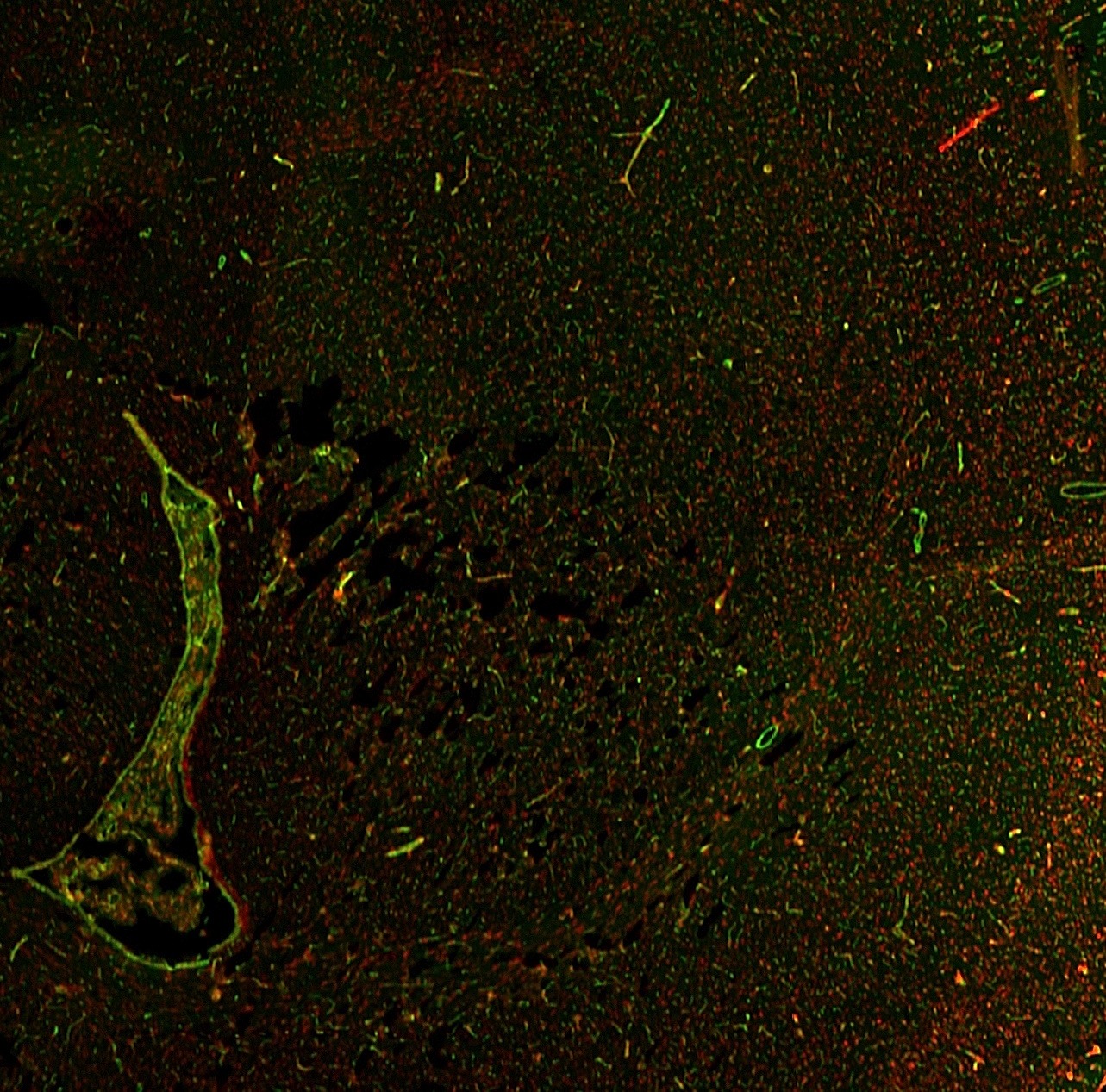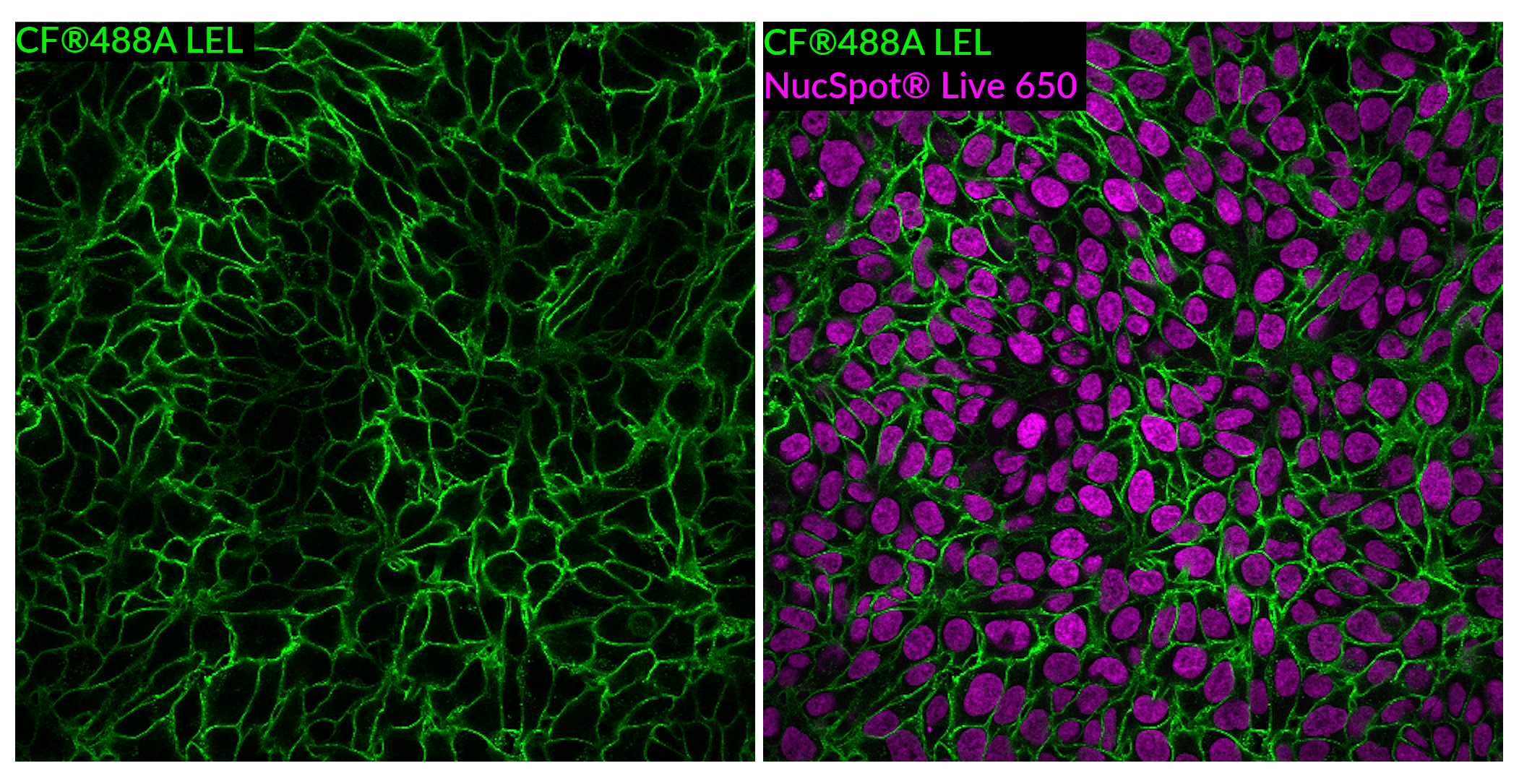Lycopersicon Esculentum (Tomato) Lectin (LEL, TL) Conjugates
Tomato lectin (LEL, TL) CF® Dye conjugates that bind to [GlcNAc] 1,3-N-acetylglucosamine, glycophorin, and Tamm-Horsfall glycoprotein. LEL, TL is a commonly used marker for blood vessels and microglial cells in rodent and neuroscience research. Biotium offers tomato lectin conjugated to biotin and a selection of 6 bright and photostable CF® Dyes.
Please fill in the inquiry form and we will contact you shortly.
Wishlist updated! View wishlist
Product Description
Lycopersicon esculentum (Tomato) lectin (LEL, TL) is a stable single-subunit glycoprotein composed of 50 percent arabinose and galactose. The lectin binds to [GlcNAc] 1,3-N-acetylglucosamine, glycophorin, and Tamm-Horsfall glycoprotein. Tomato lectin is a commonly used marker for blood vessels and microglial cells in rodent and neuroscience research. The lectin is also a useful label for rodent tumor angiogenesis studies and in the tracing of neovascular development in xenograft models. The lectin may be used to stain tissue sections. Biotium offers tomato lectin conjugated to biotin and a selection of 6 bright and photostable CF® Dyes.
- Marker for blood vessels and microglial cells
- Binds to [GlcNAc] 1,3-N-acetylglucosamine, glycophorin, and Tamm-Horsfall glycoprotein
- Used to study tumor angiogenesis or tracing neovascular development in xenograft models
- Suitable for immunofluorescence staining in tissue sections
- Choice of 6 CF® Dyes or biotin
- Supplied at 1 mg/mL in 10 mM HEPES pH 7.5, 0.15 M NaCl, 0.08% sodium azide, 0.1 mM CaCl2
Note: CF® Dye LEL, TL conjugates are formulated with sodium azide and are not suitable for use in vivo or live cell culture
Find the Right Stain for Your Application
Tomato lectin and other lectins are carbohydrate binding proteins that recognize specific sugar moieties on glycoproteins. The presence and distribution of these targets vary between cell types and tissues. As a result, other cell surface stains or other lectin conjugates, Ulex europaeus agglutinin I (UEA I), Datura stramonium (DSL), Phaseolus vulgaris leucoagglutinin (PHA-L), Wheat Germ Agglutinin (WGA) conjugates, Concanavalin A (Con A) and Arachis hypogaea (PNA) conjugates, may produce better surface staining and may be more appropriate for your cell type. Lectin conjugates can be used to selectively stain the cell surface of live cells, and withstand fixation and permeabilization. When cells are fixed and permeabilized before staining, fluorescent lectins stain both cell surface and organelles in the secretory pathway. Lectins may be toxic or stimulatory to live cells depending on cell type. To find the right stain for your application, see our Membrane & Cell Surface Stains Comparison. See our Cellular Stains Table for more information on how our dyes stain various organisms.
Superior CF® Dyes
Biotium’s next-generation CF® Dyes were designed to be highly water-soluble with advantages in brightness and photostability compared to other fluorescent dyes. Learn more about CF® Dyes.
Lycopersicon Esculentum (Tomato) Lectin (LEL, TL) Conjugates
| Conjugation | Ex/Em | Size | Catalog No. | Dye Features |
|---|---|---|---|---|
| CF®488A | 490/516 nm | 1 mL | 29103 | CF®488A Features |
| CF®568 | 562/584 nm | 1 mL | 29104 | CF®568 Features |
| CF®594 | 593/615 nm | 1 mL | 29105 | CF®594 Features |
| CF®640R | 642/663 nm | 1 mL | 29106 | CF®640R Features |
| CF®680 | 681/698 nm | 1 mL | 29107 | CF®680 Features |
| CF®740 | 742/767 nm | 1 mL | 29132 | CF®740 Features |
| Biotin | N/A | 1 mL | 29012 |
Full List of Lectin Conjugates
| Product | Features |
|---|---|
| CF® Dye Concanavalin A (Con A) | • Cell surface stain for yeast, fungi, and mammalian cells • Selectively binds to a-mannopyranosyl and a-glucopyranosy residues • Available with a wide selection of CF® Dyes |
| CF® Dye Wheat Germ Agglutinin (WGA) | • Cell surface stain for mammalian cells and gram+ bacteria • Also stains yeast bud scars • Has high affinity for sialic acid and N-acetylglucosamine • Choose from a wide selection of CF® Dyes or HRP |
| CF® Dye Peanut Lectin (PNA) from Arachis hypogaea | • Specific for terminal β-galactose and binds preferentially to galactosyl (β-1,3) N-acetylgalactosamine • Choice of 4 CF® dye colors |
| CF® Dye Lycopersicon Esculentum (Tomato) Lectin (LEL, TL) | • Marker for blood vessels and microglial cells • Binds to [GlcNAc] 1,3-N-acetylglucosamine, glycophorin, and Tamm-Horsfall glycoprotein • Used to study tumor angiogenesis or tracing neovascular development in xenograft models • Choice of 5 CF® Dyes or biotin |
| CF® Dye Ulex Europaeus Agglutinin I (UEA I) | • Marker for human endothelial cells and incompletely differentiated gastrin cells • Binds to glycoproteins and glycolipids containing α-linked fucose residues • Choice of 5 CF® Dyes or biotin |
| CF® Dye Phaseolus Vulgaris Leucoagglutinin (PHA-L) | • Used to stimulate lymphocyte and T cell proliferation • Choice of 5 CF® Dyes or biotin |
| CF® Dye Datura Stramonium Lectin (DSL) | • Binds to (beta-1,4) linked N-acetylglucosamine oligomers • Choice of 5 CF® Dyes or biotin |
| CF® Dye Sambucus Nigra Lectin (SNA, EBL)) | • Binds to sialic acid attached to terminal galactose • Choice of 6 CF® Dyes or biotin |





